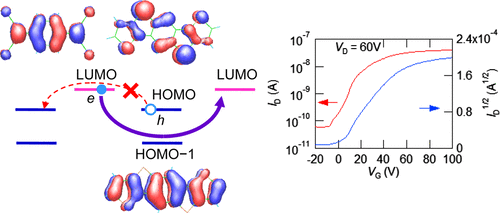当前位置:
X-MOL 学术
›
ACS Appl. Mater. Interfaces
›
论文详情
Our official English website, www.x-mol.net, welcomes your feedback! (Note: you will need to create a separate account there.)
Carrier Charge Polarity in Mixed-Stack Charge-Transfer Crystals Containing Dithienobenzodithiophene
ACS Applied Materials & Interfaces ( IF 9.5 ) Pub Date : 2018-03-06 00:00:00 , DOI: 10.1021/acsami.8b00416 Kodai Iijima 1 , Ryo Sanada 1 , Dongho Yoo 1 , Ryonosuke Sato 1 , Tadashi Kawamoto 1 , Takehiko Mori 1
ACS Applied Materials & Interfaces ( IF 9.5 ) Pub Date : 2018-03-06 00:00:00 , DOI: 10.1021/acsami.8b00416 Kodai Iijima 1 , Ryo Sanada 1 , Dongho Yoo 1 , Ryonosuke Sato 1 , Tadashi Kawamoto 1 , Takehiko Mori 1
Affiliation

|
Dithieno[2,3-d;2′3′-d′]benzo[1,2-b;4,5-b′]dithiophene forms mixed-stack charge-transfer complexes with fluorinated tetracyanoquinodimethanes (FnTCNQs, n = 0, 2, and 4) and dimethyldicyanoquinonediimine (DMDCNQI). The single-crystal transistors of the FnTCNQ complexes exhibit electron transport, whereas the DMDCNQI complex shows hole transport as well. The dominance of electron transport is explained by the superexchange mechanism, where transfers corresponding to the acceptor-to-acceptor hopping (teeff) are more than 10 times larger than the donor-to-donor hopping (theff). This is because the donor orbital next to the highest occupied molecular orbital makes a large contribution to the electron transport owing to the symmetry matching. Like this, inherently asymmetrical electron and hole transport in alternating stacks is understood by analyzing bridge orbitals other than the transport orbitals.
中文翻译:

含二噻吩并苯并二噻吩的混合堆叠电荷转移晶体中的载流子电荷极性
Dithieno [2,3- d ; 2'3'- d ']苯并[1,2- b ; 4,5- b ']二噻吩与氟化四氰基喹二甲烷形成混合堆叠电荷转移络合物(F n TCNQs,n = 0、2和4)和二甲基二氰基醌二亚胺(DMDCNQI)。F n TCNQ配合物的单晶晶体管表现出电子传输,而DMDCNQI配合物也表现出空穴传输。电子传递的优势由超交换机制解释,其中对应于受体-受体跃迁(t e eff)的转移比施主-施主跃迁(t h)大10倍以上eff)。这是因为由于对称匹配,在最高占据分子轨道旁边的供体轨道对电子传输做出了很大贡献。像这样,通过分析除传输轨道以外的桥轨道,可以理解交替堆中固有的不对称电子和空穴传输。
更新日期:2018-03-06
中文翻译:

含二噻吩并苯并二噻吩的混合堆叠电荷转移晶体中的载流子电荷极性
Dithieno [2,3- d ; 2'3'- d ']苯并[1,2- b ; 4,5- b ']二噻吩与氟化四氰基喹二甲烷形成混合堆叠电荷转移络合物(F n TCNQs,n = 0、2和4)和二甲基二氰基醌二亚胺(DMDCNQI)。F n TCNQ配合物的单晶晶体管表现出电子传输,而DMDCNQI配合物也表现出空穴传输。电子传递的优势由超交换机制解释,其中对应于受体-受体跃迁(t e eff)的转移比施主-施主跃迁(t h)大10倍以上eff)。这是因为由于对称匹配,在最高占据分子轨道旁边的供体轨道对电子传输做出了很大贡献。像这样,通过分析除传输轨道以外的桥轨道,可以理解交替堆中固有的不对称电子和空穴传输。



























 京公网安备 11010802027423号
京公网安备 11010802027423号